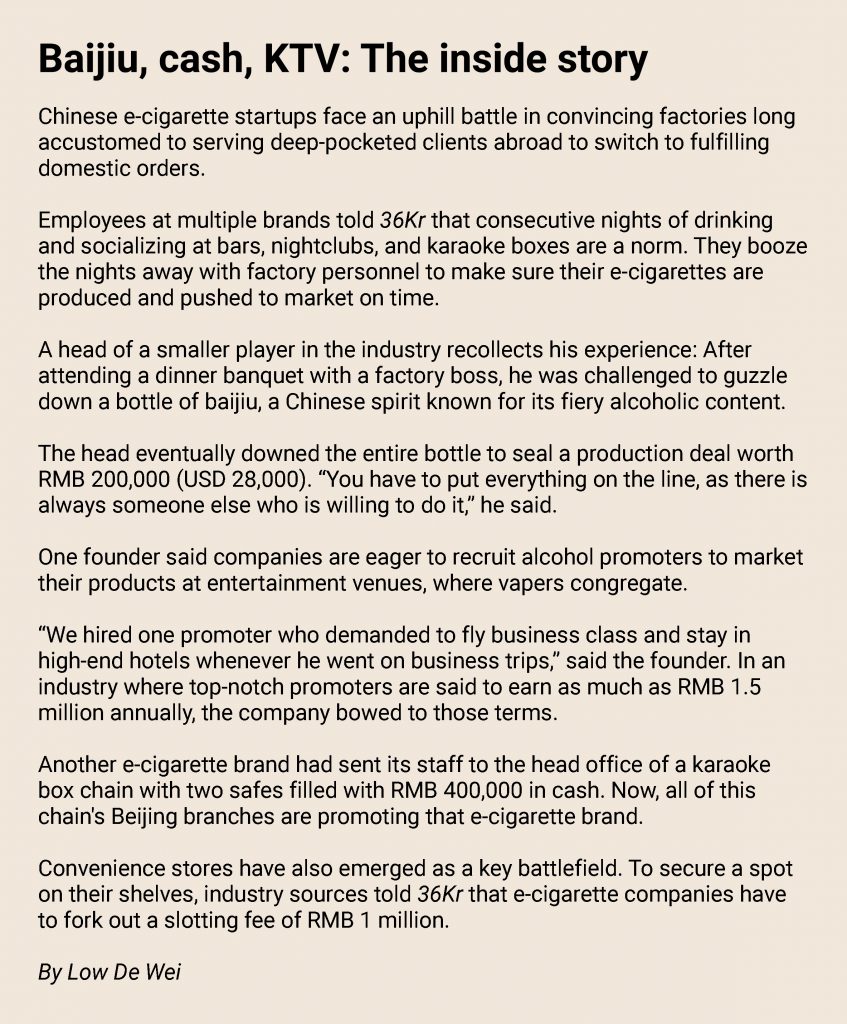Two years ago, no one in China knew about Relx Technology. Today, it is a firm valued at USD 2.4 billion, operating more than 600 outlets across the country, with more than one-third of its revenue derived from overseas.
The meteoric rise of Relx Technology, industry watchers say, reflects the opportunities—but also dangers—in store for startups seeking to tap China’s 300 million smokers.
China’s tobacco sector is the world’s largest. It has long been monopolized by the state-owned China National Tobacco, which manufactures more than 98% of tobacco products sold in the country.
The market is so huge that Beijing relies on tobacco sales for a sizable percentage of the country’s overall tax revenue. In the past two years, however, startups have found a way to break up the monopoly—thanks to the rising popularity of e-cigarettes.
Relx’s CEO Kate Wang has been leading the charge. One executive at Zhenfund, a venture fund managing more than USD 1 billion worth of assets, looks back with regret over a strategic mistake he made last year—passing on the chance to invest in Relx.
“The person has said numerous times in internal meetings how grave the mistake he has made is,” a person in the firm told 36Kr.
Wang was the general manager of Greater China for US ride-sharing giant Uber before its operation in the country was acquired by Didi Chuxing in 2016. She is known for her abrasive business style and habit of chain smoking.
Sources close to Relx told 36Kr that Wang had ignored repeated attempts by an interested “renowned investor” to arrange a meeting with her. Offended by this snub, the investor had set up a competing brand, vowing to “kill off” Relx. Wang declined to comment when approached for this story.
In a blow to Wang’s ambitions, big names have lent their firepower to new startups seeking to challenge Relx’s dominance in recent months. In April, Luo Yonghao, founder of now-defunct elite smartphone brand Smartisan, joined e-cigarette brand Flow as a co-founder.

In January, Cai Yuedong, a celebrity on social media site Weibo, launched his own e-cigarette brand, Yooz. Indeed, Relx, Yooz, and another rival brand Snow+ have taken on tens of millions of dollars in venture capital funding from high-profile investors. These companies all produce handheld, battery-powered devices that heat chemicals containing nicotine, an addictive substance found in cigarettes. Users inhale the steam—an act known as “vaping.”
These devices take on various physical forms, from Yooz’s ovalish multicolored e-cigarettes to Snow+’s reddish, USB-chargeable tubular devices. Another brand, Vvild, has sought to build brand recognition by filming an online video featuring Chinese pop star Edison Chen.
The elephant in the room
E-cigarette makers are pulling out all the stops to occupy their own corners in the growing vaping industry in China, which has nearly tripled in size since 2014, selling USD 750 million worth of related products in 2018, according to Euromonitor International, a market research provider. Despite forecasts for this figure to reach USD 895 million by the end of this year and USD 1.5 billion by 2023, small brands represent nearly 90% of the market, with no major market leader charging ahead.
While Relx took up a 2.2% market share in 2018, it was still a distant runner-up to Smok, an e-cigarette brand produced by Shenzhen IVPS Technology, which sells 8% of vaping products in China.
Amid pitch battles, the major challenge of e-cigarette makers remains tighter government regulations. While there is still a limited understanding of the health risks posed by vaping, the practice is said to be a healthier alternative to puffing on cigarettes, which contain cancer-causing carcinogens like tar.
China said it’s committed to curtailing smoking practices. With a national target to reduce smoker numbers to 20% of its population by 2030, down from 27% in 2018, indoor bans on smoking have been introduced in major cities like Shanghai and Beijing.
Authorities in Shenzhen went one step further, banning the indoor use of e-cigarettes as well.
In June, China published draft standards for the regulation of e-cigarettes, including their manufacture and testing requirements, although no date has been set for its implementation. Some industry insiders said the rules could kick in as early as October.

Industry players said a major sticking point is the proposed restriction of nicotine content to 2% in e-liquids, in line with restrictions in other countries like the United Kingdom. But most e-liquids currently being sold in China contain nicotine content of around 3–5%, with some reaching up to 6%.
Teens in China have embraced the variety of flavored e-liquids that vaping devices offer. Each bottle takes just RMB 10 (USD 1.40) to produce, and then retails for up to RMB 39, so companies have sought to carve out their niche in this area, specializing in producing e-liquids with unique tastes like bubble gum and mung bean.
An e-liquids producer predicts that as much as 90% of its peers will have to shutter if the proposed regulations come into effect. Also, e-cigarettes are currently subject to a 13% value-added tax like other consumer products, but there is rising concern that more tax hikes are on the horizon.
To add to their woes, China National Tobacco holds a monopoly over the import and production of nicotine in China. It’s in an ideal position to squeeze e-cigarette makers threatening its pole position in the market, according to Reuters.
The much-hyped entrance of Juul
Potential headwinds have not deterred others from eyeing opportunities in the Chinese market, however.
In September, US e-cigarette giant Juul Labs made its much-anticipated foray into China, setting up online stores on e-commerce sites Tmall and JD.com. The vaping giant, which dominated the US market with a 76% share last year, is reportedly planning to spend more than USD 100 million on its branding and marketing operations in China.

Its entrance to China, however, has encountered a major setback after its online product listings were taken down less than a week later. No reason was given for the withdrawal, but the company said it “looks forward to continued dialogue with stakeholders so that we can make our products available again.”
Juul last week was hit by the US government’s ban on flavored e-cigarettes from store shelves, as officials warned that sweet flavors had drawn millions of children into nicotine addiction, Reuters reported. The US health officials are also investigating a handful of deaths and potentially hundreds of lung illnesses tied to vaping.
As uncertainties loom, not everyone has signed up for the puffing war in China.
Smartphone maker Xiaomi, for one, has persistently denied its intentions to produce vaping devices. One Xiaomi employee with knowledge of the firm’s plans told 36Kr on condition of anonymity that entering the e-cigarette market now “is reckless.”
Rather than going in blind, it is preferable to proceed with caution, the employee said. But as China’s vaping war sizzles, few may share this verdict.
The original article was written by Yang Lin and Liu Siwu of 36Kr, KrASIA’s parent company.
Contact the writer at [email protected]
